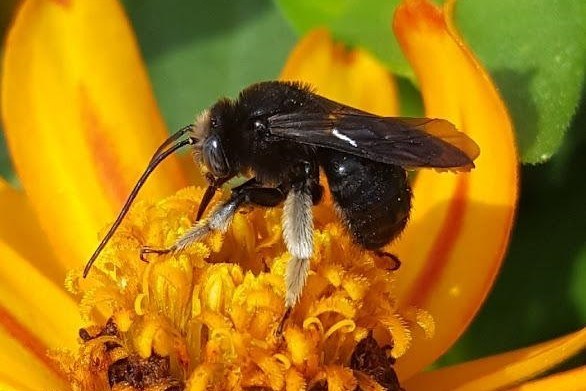Posted: June 19, 2023
Learn all about this intriguing bee that you will find in your own yard.

Photo credit: Pam Rose
Pollinator Spotlight: Melissodes bimaculatus
Meet the Two-spotted Longhorn bee, Melissodes bimaculatus. It is a common visitor in gardens, so watch for them at your home or your local public garden. This bee is named for the two white spots on the base of the abdomen (bimaculatus) and for the males' long antennae. The genus name Melissodes means "bee-like." The majority of Melissodes species are specialists, meaning they collect pollen from only one family or genera of plants. However, Melissodes bimaculatus is a generalist, meaning it will collect pollen and nectar from a wide variety of plants.
Taxonomy
Melissodes bimaculatus is in the tribe Eucerini (Longhorn Bees), the most diverse tribe in the family Apidae. This bee is one of nearly 100 species of Melissodes in the United States and one of 16 in Pennsylvania.
Where can you find it?
This species can be found in most of the Eastern United States, although a few have been observed in the Rocky Mountain states. It is abundant in cities and farms.
Morphology and Life History
Melissodes bimaculatus is an all-black bee, with white hairs on its legs and two white spots on the base of its abdomen.
Males are 11-13 mm long and have a yellow-white face (clypeus). Females are 13-15 mm and have long white
pollen-collecting hairs (scopae) on their hind legs that resemble loaded saddle bags when coated with pollen. They are a solitary bee, emerging from the ground in late June and active until mid-August. After mating, the female will dig a tunnel in the ground, preferring slopes and banks. She will collect nectar and pollen to provision each nest cell, lay an egg, seal the cell, and start building the next cell. The female spends each night in her nest, but males can often be found sleeping on grasses and sticks in groups called "aggregations."
Plant use
This bee will collect nectar and pollen from a wide variety of plants including squash, morning glory, primrose, mountain mint, goldenrod, beebalm, zinnia, fragrant (anise) hyssop and harebell.
Natural enemies
The larvae are parasitized by cuckoo bees, Triepeolus spp., a cleptoparasitic bee that invades the nests of Melissodes bimaculatus. The cuckoo bee will lay an egg in the nest; when it hatches, it will kill the host larvae and eat the pollen store.
Be on the lookout for the Two-spotted longhorn bee in your own garden or community garden. They visit such a wide variety of flowers that chances are good that there will be something they like!
References
Holm, Heather, Pollinators of Native Plants, 2014
Wilson, Joseph S. & Carril, Olivia Messinger, The Bees in Your Backyard, 2016
June 2023, contributed by Pam Rose

